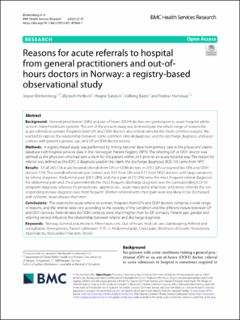| dc.contributor.author | Blinkenberg, Jesper | |
| dc.contributor.author | Hetlevik, Øystein | |
| dc.contributor.author | Sandvik, Hogne | |
| dc.contributor.author | Baste, Valborg | |
| dc.contributor.author | Hunskaar, Steinar | |
| dc.date.accessioned | 2022-06-08T10:42:09Z | |
| dc.date.available | 2022-06-08T10:42:09Z | |
| dc.date.created | 2022-05-11T11:24:39Z | |
| dc.date.issued | 2022 | |
| dc.identifier.citation | BMC Health Services Research. 2022, 22 (1), . | en_US |
| dc.identifier.issn | 1472-6963 | |
| dc.identifier.uri | https://hdl.handle.net/11250/2997856 | |
| dc.description.abstract | Background General practitioners (GPs) and out-of-hours (OOH) doctors are gatekeepers to acute hospital admissions in many healthcare systems. The aim of the present study was to investigate the whole range of reasons for acute referrals to somatic hospitals from GPs and OOH doctors and referral rates for the most common reasons. We wanted to explore the relationship between some common referral diagnoses and the discharge diagnosis, and associations with patient’s gender, age, and GP or OOH doctor referral. Methods A registry-based study was performed by linking national data from primary care in the physicians’ claims database with hospital services data in the Norwegian Patient Registry (NPR). The referring GP or OOH doctor was defined as the physician who had sent a claim for the patient within 24 h prior to an acute hospital stay. The reason for referral was defined as the ICPC-2 diagnosis used in the claim; the discharge diagnoses (ICD-10) came from NPR. Results Of all 265,518 acute hospital referrals from GPs or OOH doctors in 2017, GPs accounted for 43% and OOH doctors 57%. The overall referral rate per contact was 0.01 from GPs and 0.11 from OOH doctors, with large variations by referral diagnosis. Abdominal pain (D01) (8%) and chest pain (A11) (5%) were the most frequent referral diagnoses. For abdominal pain and chest pain referrals the most frequent discharge diagnosis was the corresponding ICD-10 symptom diagnosis, whereas for pneumonia-, appendicitis-, acute myocardial infarction- and stroke referrals the corresponding disease diagnosis was most frequent. Women referred with chest pain were less likely to be discharged with ischemic heart disease than men. Conclusions The reasons for acute referral to somatic hospitals from GPs and OOH doctors comprise a wide range of reasons, and the referral rates vary according to the severity of the condition and the different nature between GP and OOH services. Referral rates for OOH contacts were much higher than for GP contacts. Patient age, gender and referring service influence the relationship between referral and discharge diagnosis. | en_US |
| dc.language.iso | eng | en_US |
| dc.rights | Navngivelse 4.0 Internasjonal | * |
| dc.rights.uri | http://creativecommons.org/licenses/by/4.0/deed.no | * |
| dc.title | Reasons for acute referrals to hospital from general practitioners and out-of-hours doctors in Norway: a registry-based observational study | en_US |
| dc.title.alternative | Reasons for acute referrals to hospital from general practitioners and out-of-hours doctors in Norway: a registry-based observational study | en_US |
| dc.type | Peer reviewed | en_US |
| dc.type | Journal article | en_US |
| dc.rights.holder | © The Author(s) 2022 | en_US |
| dc.description.version | publishedVersion | en_US |
| cristin.ispublished | true | |
| cristin.fulltext | original | |
| cristin.qualitycode | 2 | |
| dc.identifier.doi | 10.1186/s12913-021-07444-7 | |
| dc.identifier.cristin | 2023439 | |
| dc.source.journal | BMC Health Services Research | en_US |
| dc.source.volume | 22 | en_US |
| dc.source.issue | 1 | en_US |
| dc.source.pagenumber | 0 | en_US |

